There is a lot of activity in the sub-$1,500 gaming laptop market, and that is excellent news for gamers looking to score a performance bargain. Lenovo's Legion LOQ 15 is a spec-bump entry into this segment, featuring a familiar chassis but a newer AMD Ryzen 7 250 processor, an Nvidia GeForce RTX 5060 GPU (115W TGP), and a $1,299 asking price.
While the fundamentals are sound, Lenovo made some curious choices here, such as 16GB of single-channel DDR5, a modest 512GB SSD, and a limiting 60 Whr battery, putting this system in an odd space between budget and mid-range systems. Read on to see how those decisions affect performance compared to the tough competition in this space.
Design of the Lenovo Legion LOQ 15
I reviewed the previous iteration of the Legion LOQ 15 in December 2024, and this new model doesn’t break new ground in design. In fact, as far as I can tell, the chassis is identical to last year’s model right down to the gray color and port layout. However, that’s not a bad thing, because I find the laptop looks clean and attractive.
To keep costs down, the Legion LOQ 15 is constructed of high-quality plastic all around, including the lid (which is adorned with LOQ branding and a Lenovo placard). The primary chassis/keyboard deck, as well as the lid, has a metallic silver finish, while the display bezels are dark gray. Lenovo doesn’t take any real design risks with the laptop, although I do like that the power button and the surrounding three-segment LED ring are shaped like the “O” in the LOQ logo.
My criticism of Lenovo’s sticker bombardment with the previous LOQ 15 fell on deaf ears, because there are still three stickers (AMD Ryzen, Nvidia GeForce, and Lenovo eSupport) next to the Lenovo placard on the lower right corner of the keyboard deck.
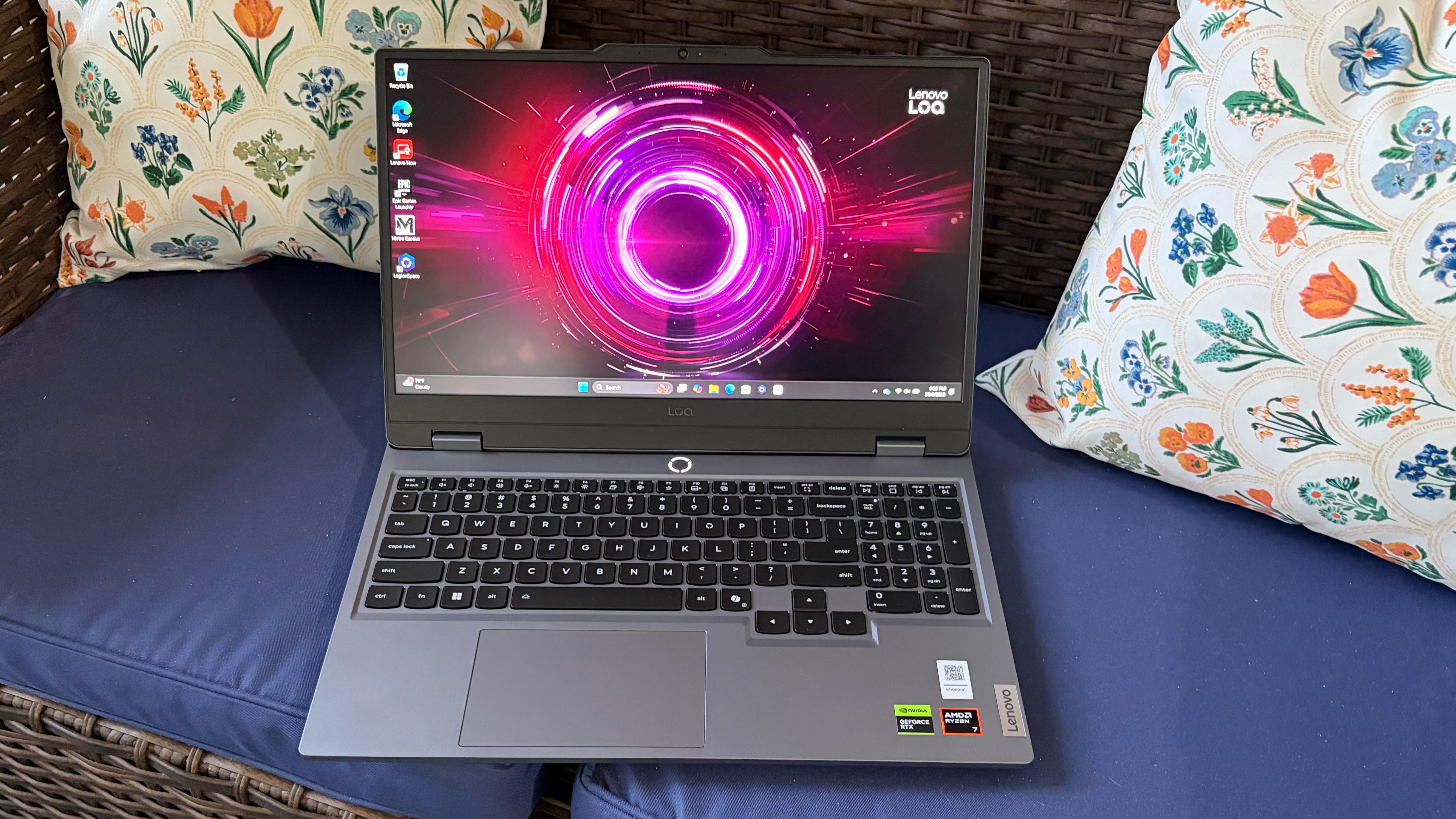
The I/O ports remain unchanged, meaning you’ll find a USB Type-A, USB-C, and a 3.5 mm jack on the right side. A physical switch for turning the webcam on or off sits between the USB-C port and the 3.5 mm jack. The remaining ports are located on the rear I/O panel, where you’ll find a proprietary Lenovo power port, an Ethernet jack, two additional USB-A ports, and HDMI.
I was taken by surprise when I first booted up the Legion LOQ 15. I attempted to connect the 6 GHz band on my Wi-Fi 7 router to download updates and utilities for the laptop, only to find that it couldn’t find any of my 6 GHz SSIDs. I navigated to Device Manager to see that Lenovo is using a MediaTek MT7921 Wi-Fi 6 card. In this day and age, I’d expect at least a Wi-Fi 6E card, and many new laptops have already transitioned to Wi-Fi 7. Luckily, upgrading to a newer wireless adapter is a relatively cheap and easy upgrade for the Legion LOQ 15.
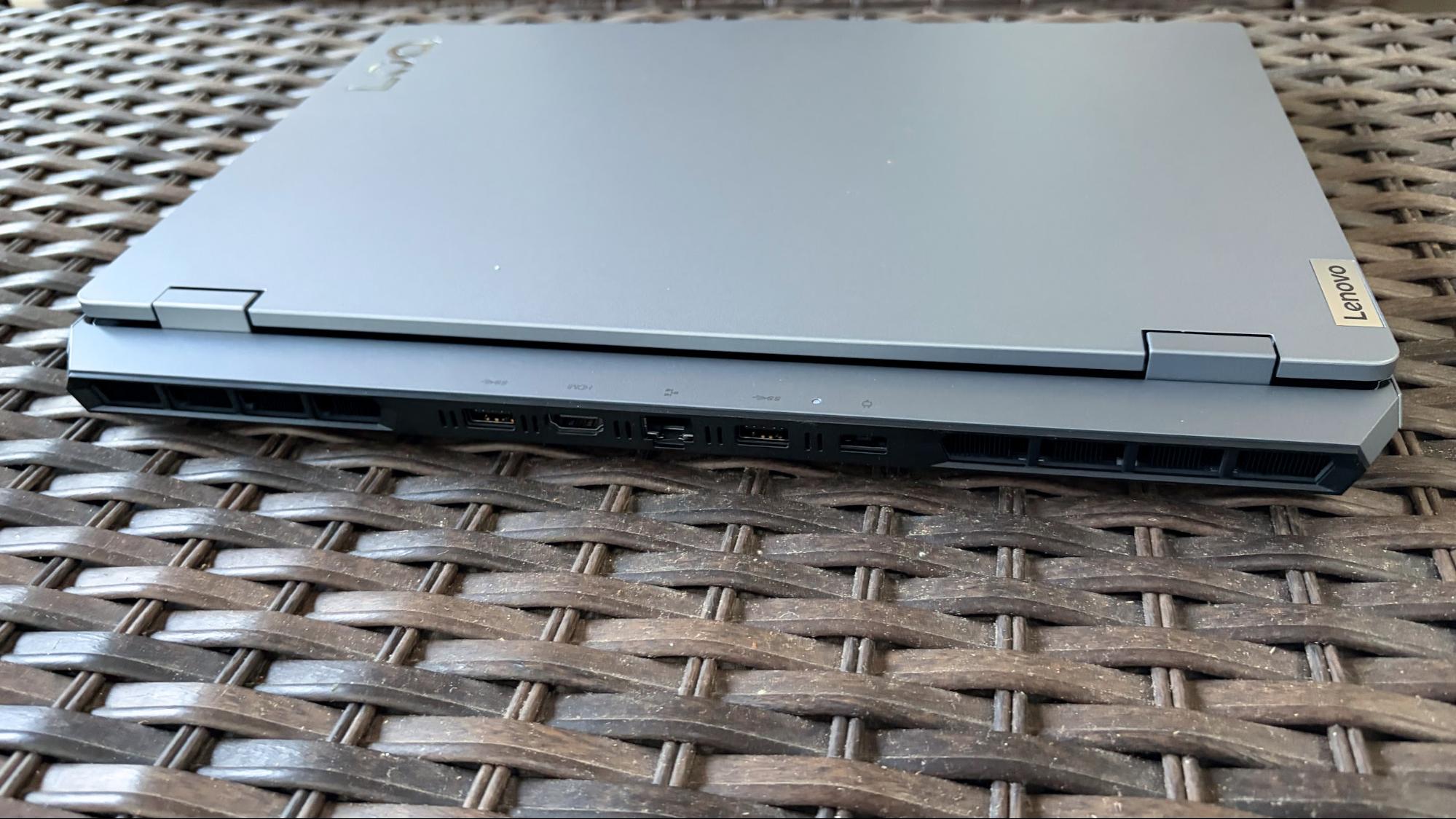
The Legion LOQ 15 measures 14.17 x 10.19 x 0.94 inches and weighs 5.12 pounds. For comparison, the Acer Nitro V 16S AI measures 14.08 x 10.39 x 0.79 inches and weighs 5.5 pounds, while the 16 Aurora is 14.05 x 10.45 x 0.89 inches and weighs 5.64 pounds. Finally, the MSI Katana 17 HX weighs 5.95 pounds with dimensions of 15.66 x 10.85 x 1.09 inches.
Lenovo Legion LOQ 15ARP9 Specifications
Swipe to scroll horizontally
CPU | AMD Ryzen 7 250 (8 cores / 16 threads, up to 5.1 GHz) |
Graphics | Nvidia GeForce RTX 5060 (8GB, 1,455 MHz boost, 115W TDP) |
Memory | 16 GB DDR5-5600 (1 x 16 GB SODIMM) |
Storage | 512GB M.2 2242 PCIe NVMe SSD |
Display | 15.6-inch, 1920 x 1080, IPS, 16:9, 144 Hz |
Networking | MediaTek Wi-Fi 6 MT7921 (802.11ax), Bluetooth 5.1 |
Ports | 1x USB Type-C, 3x USB 3.2 Gen 2 Type-A, 3.5 mm headphone jack, 1 GbE Ethernet, HDMI |
Camera | 1080p IR |
Battery | 60 WHr |
Power Adapter | 170W, proprietary |
Operating System | Windows 11 Home |
Dimensions (WxDxH) | 14.17 x 10.19 x 0.94 inches |
Weight | 5.12 pounds (2.32 kg) |
Price (as configured) | $1,299.99 |
Gaming Performance on the Lenovo Legion LOQ 15
Our Legion LOQ 15 review unit features an AMD Ryzen 7 250 “Hawk Point” processor (8 cores, 16 threads) paired with 16GB of DDR5-5600 memory (1 x 16GB SODIMM) in a single-channel configuration. The chip has a base clock of 3.3 GHz and can boost to a maximum of 5.1 GHz. The laptop also uses a GeForce RTX 5060 GPU, which in this configuration has a maximum boost clock of 1,455 MHz and a maximum TGP of 115 watts. The RTX 5060 drives a 15.6-inch 1080p IPS display with a maximum refresh rate of 144 Hz.
My go-to game for testing new gaming laptops is Indiana Jones and the Great Circle, and the Legion LOQ 15 was no exception. At the native 1080p resolution with the Ultra preset, I averaged just under 100 frames per second (FPS), depending on the level of on-screen action.
Swipe to scroll horizontally
Price (as-tested) | CPU | GPU | Display | Memory | Storage | Battery | Weight | Ethernet | Wireless | |
Lenovo Legion LOQ 15 | $1,299 | AMD Ryzen 7 250 | GeForce RTX 5060 | 15.6-inch 1920 x 1080 | 16GB DDR5-5600 | 512GB | 60 WHr | 5.12 lbs | 1 GbE | Wi-Fi 6 |
$1,299 | AMD Ryzen 7 260 | GeForce RTX 5060 | 16-inch, 1920 x 1200 | 32GB DDR5-5600 | 1TB | 76 WHr | 4.55 lbs | 1 GbE | Wi-Fi 6E | |
$1,499 | Intel Core i7-240H | GeForce RTX 5060 | 16-inch, 2560 x 1600, 120 Hz | 32GB DDR5-5600 | 1TB | 96 WHr | 5.64 lbs | 1 GbE | Wi-Fi 7 | |
$1,299 | Intel Core i7 14650HX | GeForce RTX 5070 | 17.3-inch, 1920 x 1080, 144 Hz | 16GB DDR5-5600 | 1TB SSD | 75 WHr | 5.95 lbs | 1 GbE | Wi-Fi 6E |
Beginning with the Shadow of the Tomb Raider benchmark (Highest settings), the Legion LOQ 15 put up a strong showing with 105 frames per second (FPS) at 1080p resolution. That was good enough for second place, putting it slightly ahead of the Nitro V 16S AI (RTX 5060, 85W TGP) and the 16 Aurora (RTX 5060, 80W TGP). Understandably, the Katana 17 HX was the leader of this group (RTX 5070, 115W TGP) at 119 FPS.
It was a similar story with Cyberpunk 2077 (Medium settings), as the Legion LOQ 15 tied the Nitro V 16S AI with 32 FPS at 1080p, just barely edging out the 16 Aurora, which garnered 30 FPS. The Katana 17 HX was ahead of the field with 39 FPS at 1080p.
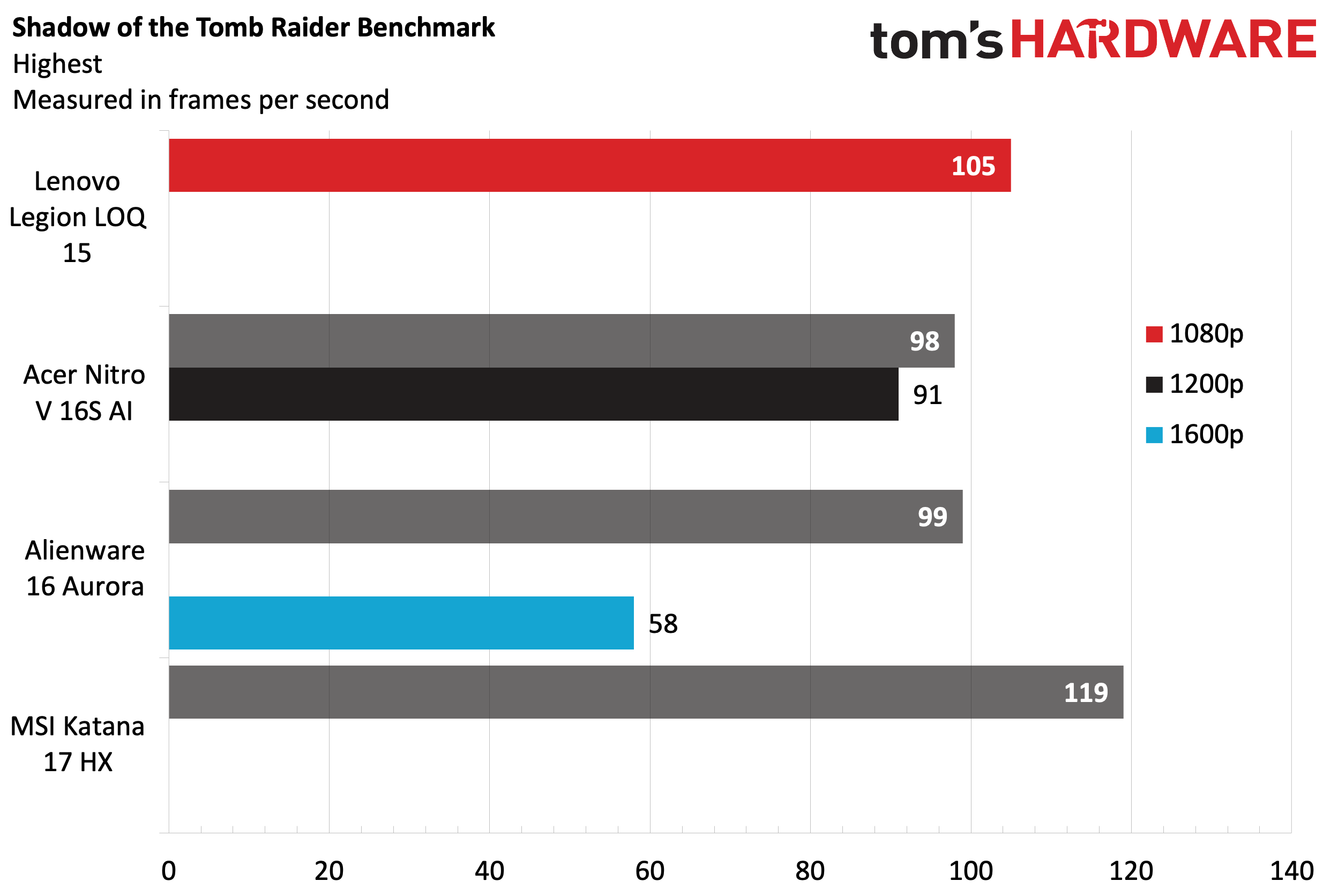
The tables were turned in the Far Cry 6 benchmark (Ultra settings), which saw the Legion LOQ 15 pull up the rear by a fair margin. It only managed 73 FPS at 1080p resolution, whereas the Nitro V 16S AI and 16 Aurora stretched to 82 FPS and 81 FPS, respectively. The Katana 17 HX again showed its graphics muscle, achieving 94 FPS at 1080p.
The three RTX 5060 laptops were clustered tightly in the Red Dead Redemption 2 benchmark (Medium settings), with the Legion LOQ 15 and Nitro V 16S AI both scoring 68 FPS. The 16 Aurora was just a head with 70 FPS, while the Katana 17 HX left the others in the dust at 85 FPS.
Finally, the Legion LOQ 15 stretched its legs a bit in the Borderlands 3 benchmark (Badass settings), as it achieved 88 FPS compared to 82 FPS for the Nitro V 16S AI and 83 FPS for the 16 Aurora. The Katana 17 HX flexed its RTX 5070 muscle once again, achieving 101 FPS at 1080p.
Metro Exodus is our tried and true benchmark for stress-testing gaming laptops, and we run each through 15 runs to monitor clock speeds and temperatures for the CPU and GPU. Using the RTX preset, the Legion LOQ 15 averaged 71.23 FPS at 1080p resolution. The CPU cores averaged 3.88 GHz, while the RTX 5060 averaged 2.42 GHz.
Productivity Performance on the Lenovo Legion LOQ 15
Our Lenovo Legion LOQ 15 review unit features the Ryzen 7 250 processor, 16GB of DDR5-5600 memory (single-channel), and a 512GB SSD.
The Legion LOQ 15 didn’t quite have what it takes to hang with the rest of the crowd in Geekbench 6. While its single-core score of 2,548 was in the same ballpark as the rest of the laptops, it significantly lagged behind on the multi-core benchmark (9,713). For comparison, the next-closest competitor, the Acer Nitro V 16S AI (Ryzen 7 260), scored 12,837 in multi-core, while the 16 Aurora led the field with 13,815 (Core i7-240H). Both the Ryzen 7 250 and Ryzen 7 260 are 8-core/16-thread CPUs with a 5.1 GHz boost clock, but the latter has a higher maximum configurable TDP (54 watts versus 30 watts).
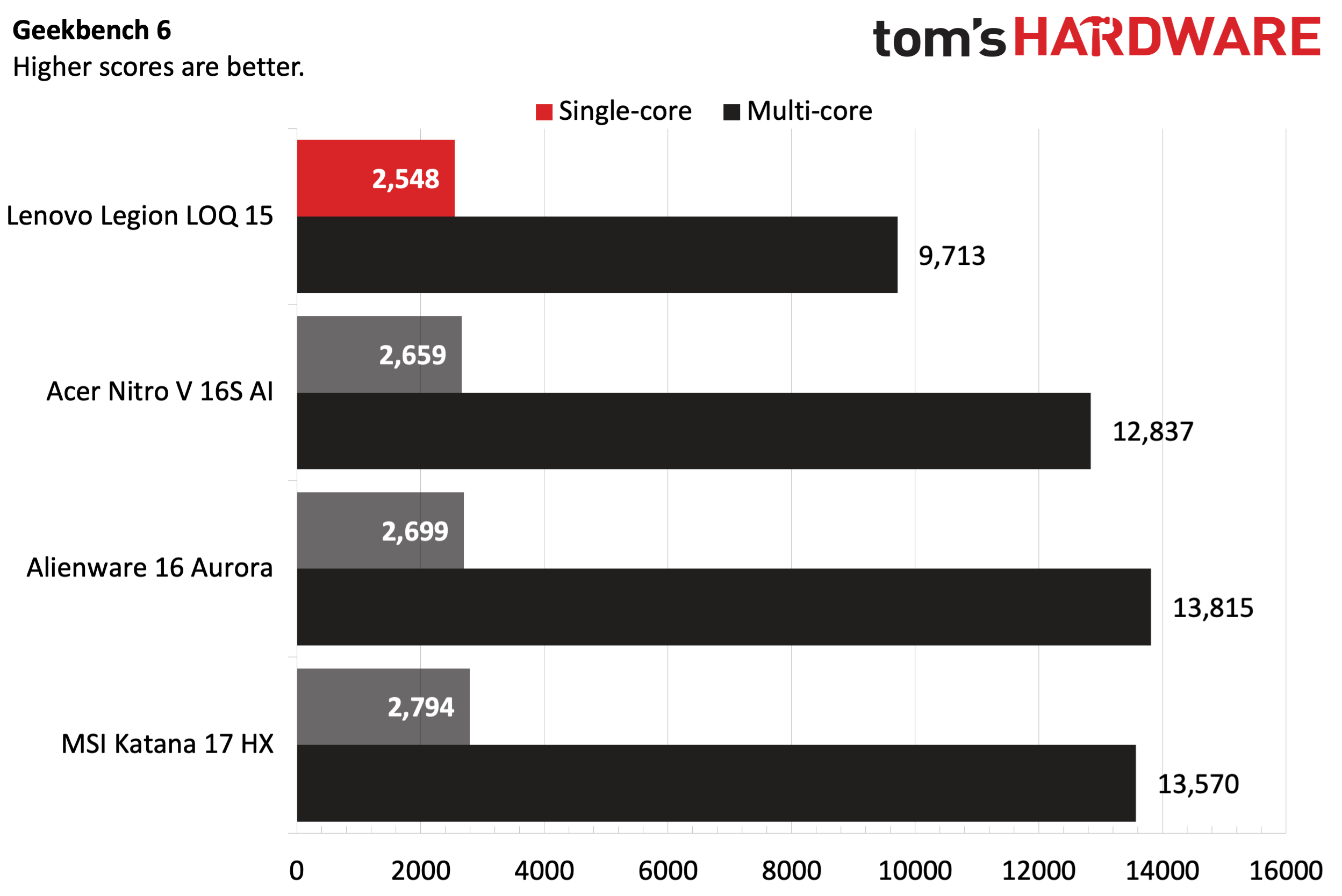
Our file transfer test, during which we copied 25GB of mixed-media files, saw the Legion LOQ 15 come in second place at 1,378.45 Mbps, behind the Nitro V 16S AI (1,838.88 Mbps).
The Legion performed relatively poorly in our Handbrake test, where we transcode a large 4K video file to 1080p. The Legion LOQ 15 took 4:56 to complete the task, compared to 4:32 for the third-place Nitro V 16S AI (which uses a Ryzen 7 260). The 16 Aurora led all contenders with a time of 4:15.
Display on the Legion LOQ 15
Lenovo has fitted the Legion LOQ 15 with a 15.6-inch 1080p IPS display, which I found to have good overall picture quality. The display features a matte, anti-reflective finish, which is typical in this price range. It helped to reduce reflections without hurting color performance. The panel maxes out at 144 Hz, which is identical to that of the Katana 17 HX.
In addition to a handful of games I played, such as Indiana Jones and the Great Circle and Forza Horizon 5, I also watched several movies, including the latest Superman release on HBO Max. I had a close eye on the red and blue hues, as they are the primary colors of Superman's iconic suit and cape. The colors were vibrant and well-saturated, with no distracting color shifts when viewing off-angle.
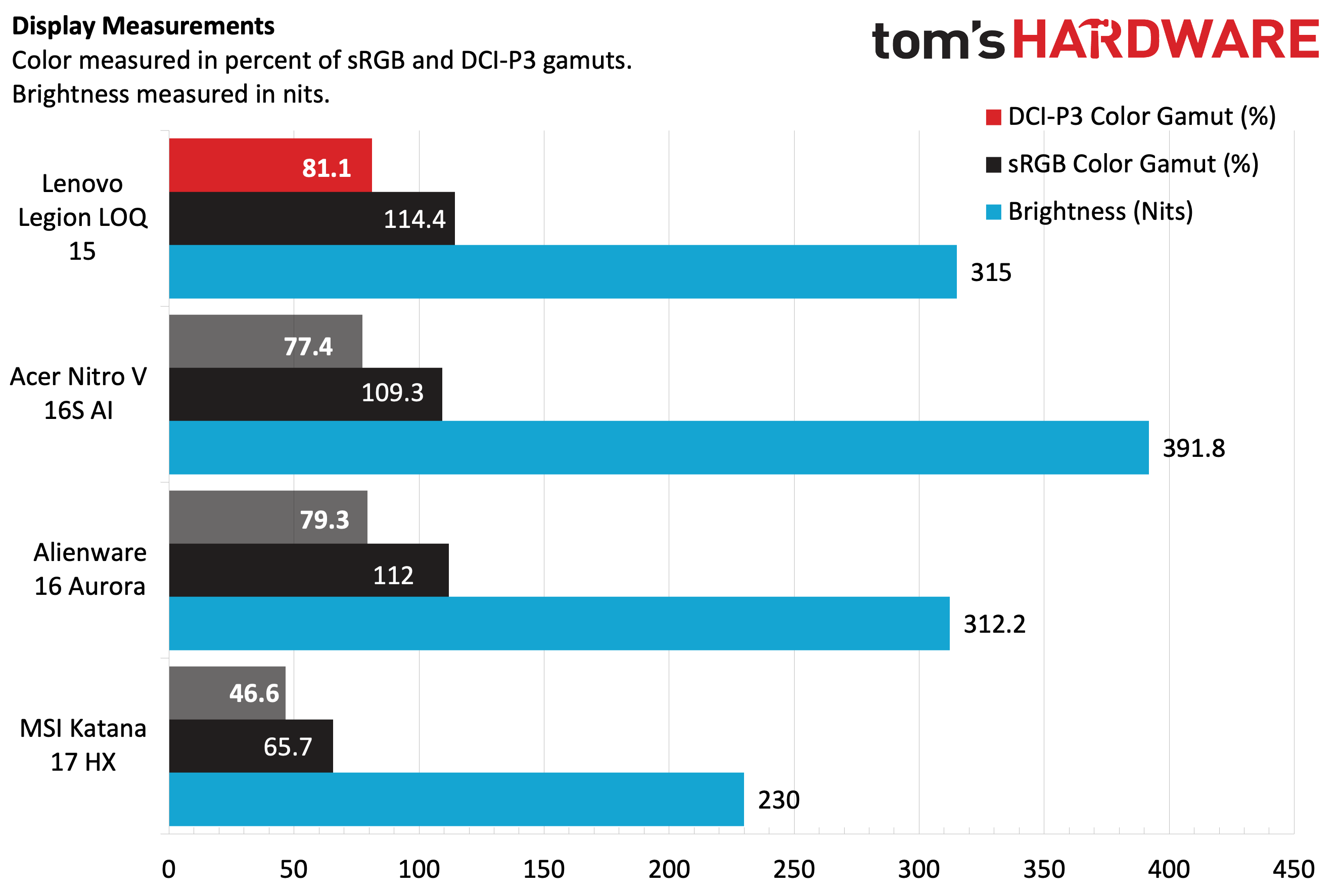
Black levels were also well-maintained, although they weren't quite as dark as those I've experienced with more expensive OLED panels.
The LOQ performed slightly better than the previous generation that we tested last year on our instrumented tests. It covered 81.1 percent of DCI-P3 and 114.4 percent of sRGB, placing it ahead of all other competitors, albeit by only a few percentage points. Our light meter showed that the IPS display reached an average of 315 nits, putting it just a step ahead of the 16 Aurora (312.2 nits), but well behind the Nitro V 16S AI (391.8 nits).
Keyboard and Touchpad on the Lenovo Legion LOQ 15
As was the case with the preceding Legion LOQ 15 I tested, I love the keyboard on our review unit. Lenovo has always been an excellent purveyor of keyboards, especially on its ThinkPad business laptops. Each key has 1.5 mm of travel, and there's enough space on the relatively large frame to squeeze in a number pad (which I appreciate for data entry). You get full-size directional keys, which is a blessing since some laptop manufacturers attempt to cram in half-size keys to save space. However, if you’re into fancy RGB effects, you won’t find them here. The Legion LOQ 15 has a single-zone white LED backlighting.
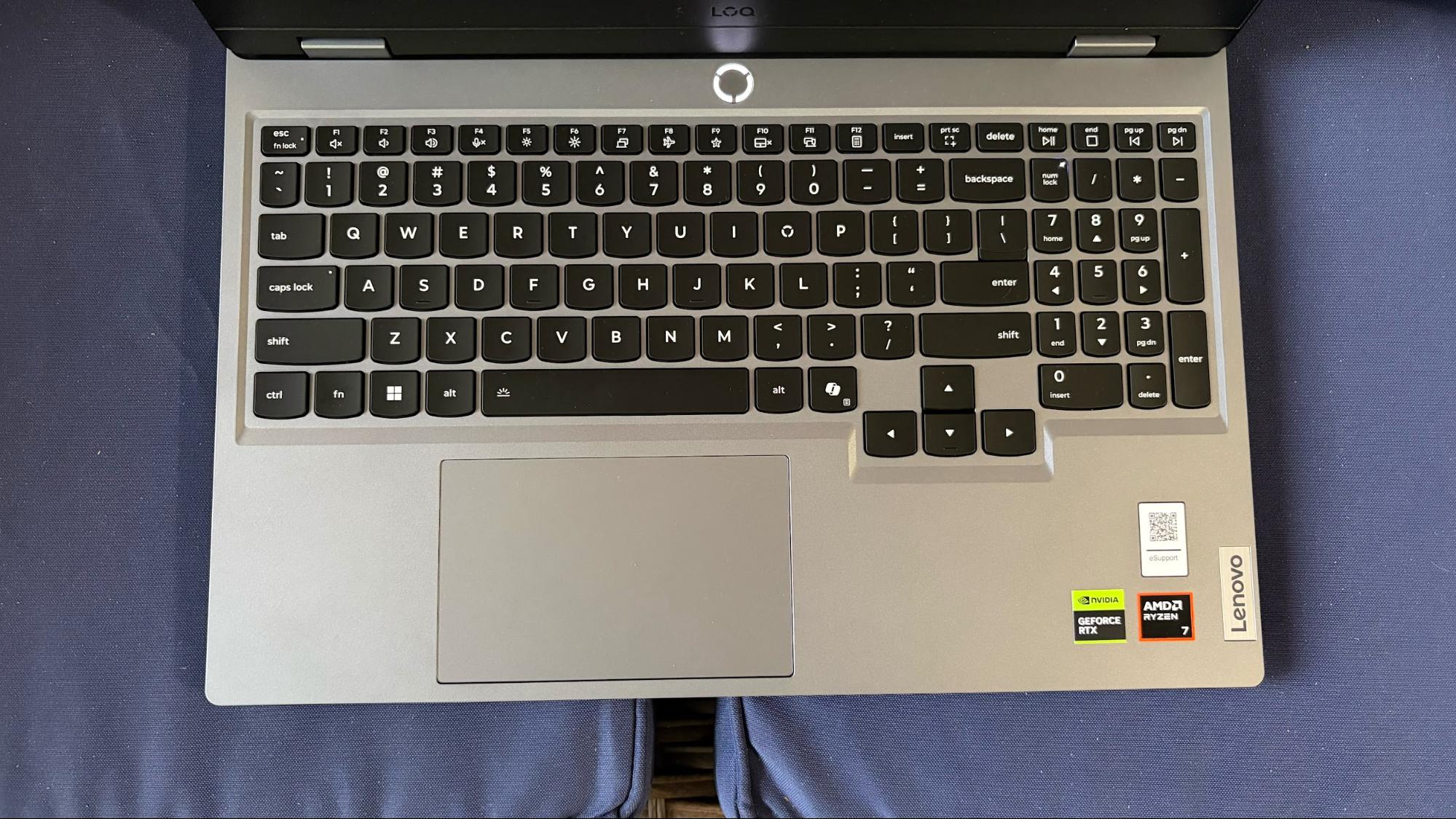
I use Keyhero.com to measure my typing speed, and unsurprisingly, my result of 89 words per minute with 96 percent accuracy was nearly identical to last year's result.
Lenovo hasn't improved the touchpad, so my complaints with last year’s models remain the same: the top quarter of the trackpad doesn't register a click due to the top-hinged design, and the surface doesn't lend itself to smooth finger gliding.
Audio on the Lenovo Legion LOQ 15
Our Legion LOQ 15 review features two 2-watt speakers, which sound a bit below average for this class. However, given the price point of our review unit, it's understandable that Lenovo didn't put much thought into the design and performance of the speakers.
Bass is non-existent, gunfire effects in games sounded tinny, and music just wasn't enjoyable. My favorite song of all time is "The Dreaming Tree" by The Dave Matthews Band, but Dave's vocals just didn't resonate with me with the Legion LOQ 15’s speakers. His voice remains calm throughout the song, which should allow the soft bass line to emerge in the background. However, with the Legion LOQ 15's speakers, the bass line is barely audible as Dave sings. The included Nahimic software didn’t make a noticeable improvement in the sound, no matter what profiles I selected.
Upgradeability on the Lenovo Legion LOQ 15
Accessing the inside of the Legion LOQ 15 is accomplished by first removing the ten screws that hold the bottom panel. With the screws removed, I used a small plastic spudger tool to pry the panel away from the main chassis.
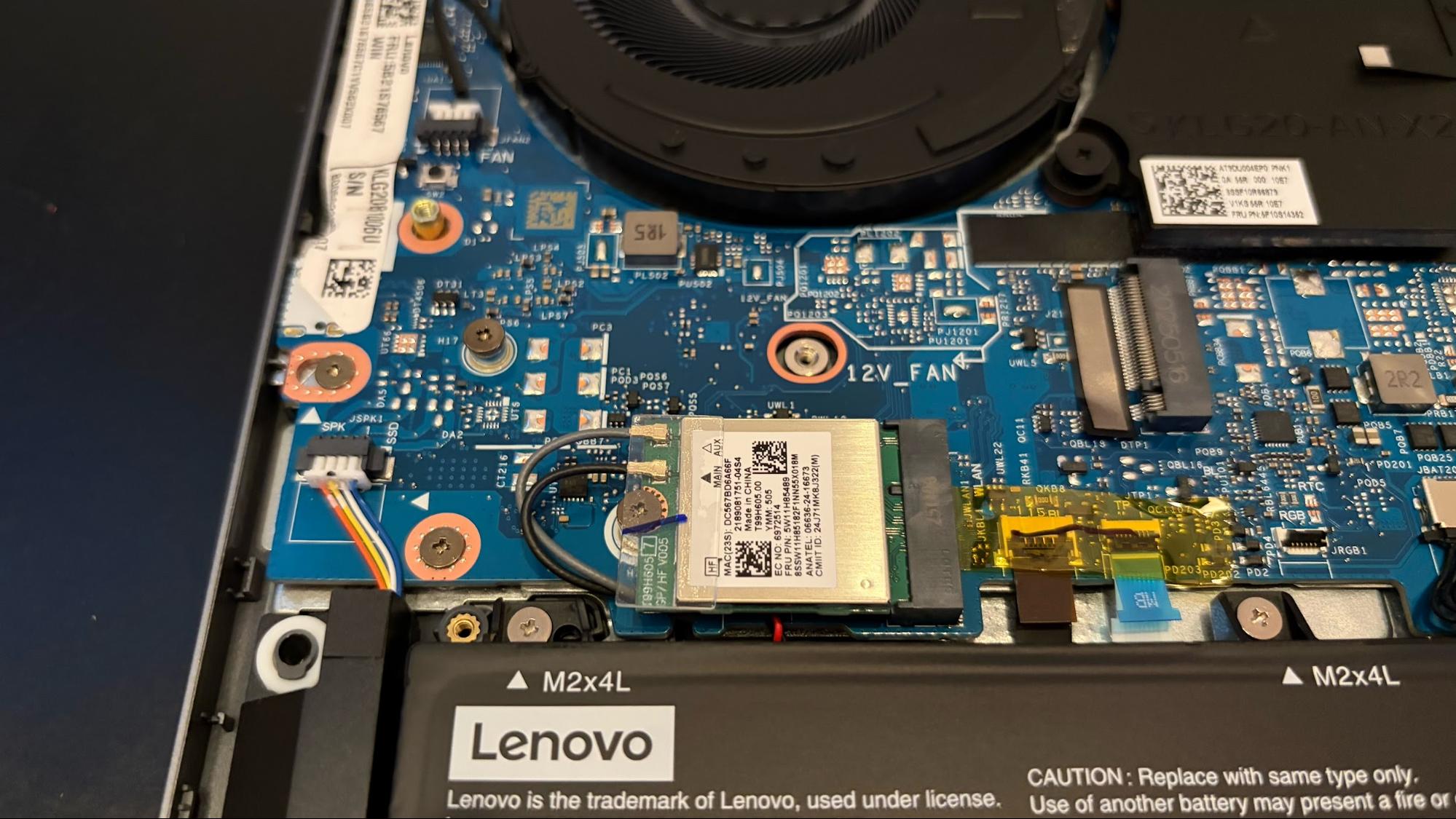
With the panel removed, you'll see the M.2 2242 installed on the right (it will accommodate 2280 SSDs as well). There's also a second M.2 slot, which allows you to install longer 2280 SSDs, sitting empty below the left exhaust fan in the picture above.
Below the second M.2 slot is the MediaTek Wi-Fi 6 module, while the two SODIMM slots are situated in the center of the chassis — only one was occupied on our review unit.
Battery Life on the Lenovo Legion LOQ 15
The Legion LOQ 15 is by no means a battery endurance champion, as evidenced by its performance compared to its peers. During our battery test, which consists of web browsing, video streaming over Wi-Fi, and conducting OpenGL tests with the screen brightness set at 150 nits, our review unit lasted just 6 hours and 50 minutes. Only the Katana 17 HX had a shorter runtime (6:21), while the Nitro V 16S AI delivered nearly three and a half more hours of endurance (10:17) compared to the Legion LOQ 15.
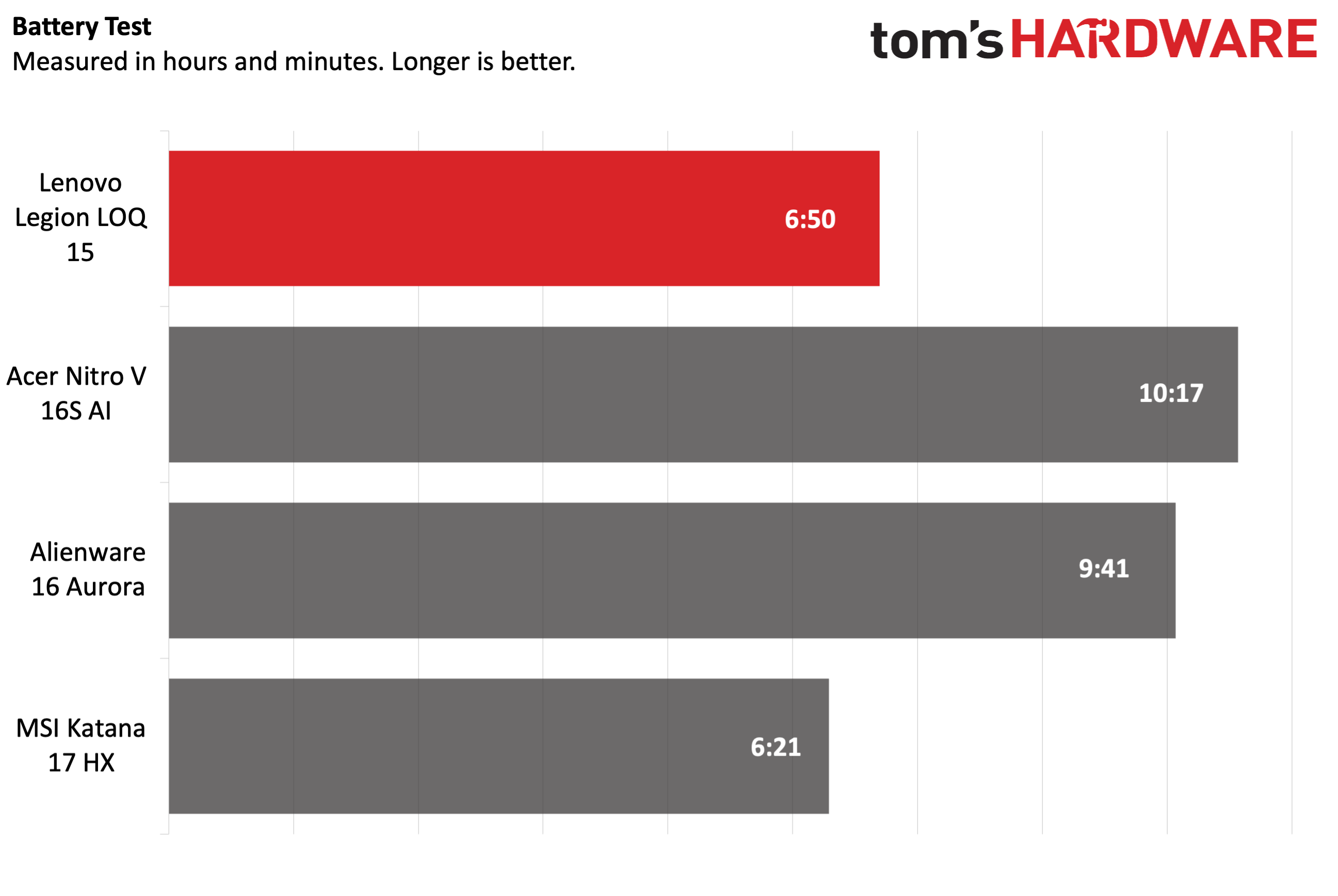
You can chalk that performance up to the relatively small 60 Whr battery, compared to the competition, which uses batteries ranging from 75 Whr to 96 Whr.
Heat on the Lenovo Legion LOQ 15
We measure laptop skin temperatures on gaming laptops while running the Metro Exodus benchmark utility over 15 loops. Fan noise was very apparent during stress testing, as is the case with most gaming laptops. However, that's an issue that is easily resolved by wearing a pair of the best gaming headsets.
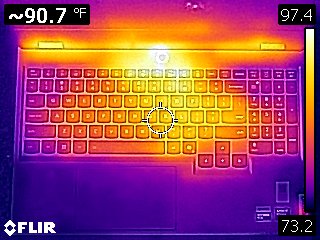
The center of the touchpad measured 74.1 degrees Fahrenheit, while I measured 95.7 F between the G and H keys. The underside of the chassis registered 97.9 F, while the hottest part of the laptop was near the right exhaust fan (116 F).
During the Metro Exodus stress test, the CPU package measured 57.3 degrees Celsius (C). Meanwhile, the RTX 5060 chimed in at 67.9 C.
Webcam on the Lenovo Legion LOQ 15
Lenovo includes a 1080p webcam on the Legion LOQ 15, and it’s actually quite good. I don’t know if Lenovo was able to secure a different supplier this time around compared to last year’s model, but the problems I previously had with skin tones were nonexistent on this review unit. In addition, images appeared clear and bright without any graininess or aggressive background processing. Overall, I was very impressed, especially at this price point.
Also, there is a physical switch on the right side of the chassis that lets you quickly enable or disable the webcam, which is a nice touch.
Software and Warranty on the Lenovo Legion LOQ 15
The headlining software included with the Legion LOQ 15 is Legion Space, which is an all-in-one utility that allows you to manage power profiles for your CPU and GPU. The main menu also displays your system's vitals, including RAM/CPU/GPU utilization, temperatures, and fan speeds. You also have quick access to your installed games, and can even purchase new games from Lenovo's store, though most gamers will probably continue to use Steam, Epic, and GOG.
Other preinstalled software packages include Lenovo AI Now, Lenovo Now, Lenovo Subscription Marketplace, Lenovo Vantage, Nahimic (sound profiles), and Smart Connect (stream content between other Lenovo and Motorola devices).
The Legion LOQ 15 comes with a one-year manufacturer's warranty from the factory.
Lenovo Legion LOQ 15 Configurations
Our Legion LOQ 15 review unit came equipped with a Ryzen 7 250 CPU, 16GB DDR5-5600 memory, a 512GB SSD, GeForce RTX 5060, and a 144Hz 15.6-inch 1080p IPS display. The configuration is listed on Lenovo’s website as “Coming Soon” with a price tag of $1,299.
With that said, another configuration available on Lenovo’s website includes a Ryzen 7 250, 16GB DDR5-5600, a 1TB SSD, and an RTX 5050 GPU for $1,189.99. There’s yet another configuration available on Amazon that is nearly identical in specifications to our review unit, with the only difference being that it has a 1TB SSD instead of a 512GB SSD – it’s priced at $1,389.
Bottom Line
The Legion LOQ 15 delivers solid gaming numbers, often outpacing other RTX 5060 laptops due to its 115W TGP. However, the laptop also struggled in some productivity tasks, especially where multi-threaded performance was crucial.
Compounding matters is the relatively short battery life, which is over three hours shorter than the Nitro V 16S AI. While I have high praise for the 15.6-inch IPS display, the speakers were mediocre. There’s also the matter that there’s only 16GB of single-channel DDR5 memory and a small 512GB SSD, which will quickly fill up with games.
Recommending the Legion LOQ 15 comes with a huge disclaimer. The laptop is showing up as not yet available on Lenovo’s website with an MSRP of $1,299. That price should be a non-starter for the features that you get. However, if you can find the laptop for closer to $1,000 (once it becomes available), many of its sins could be forgiven.

 1 month ago
25
1 month ago
25
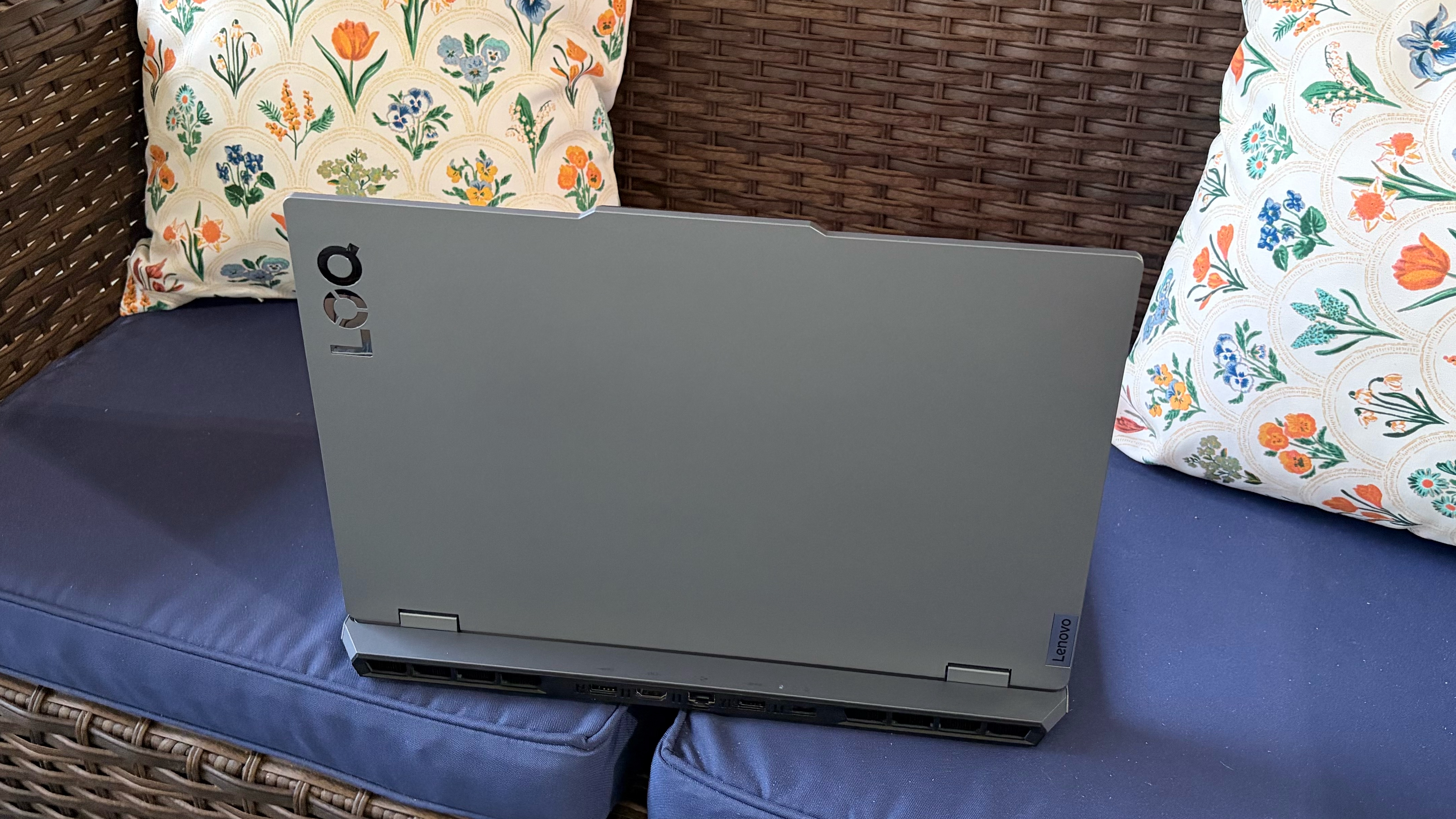
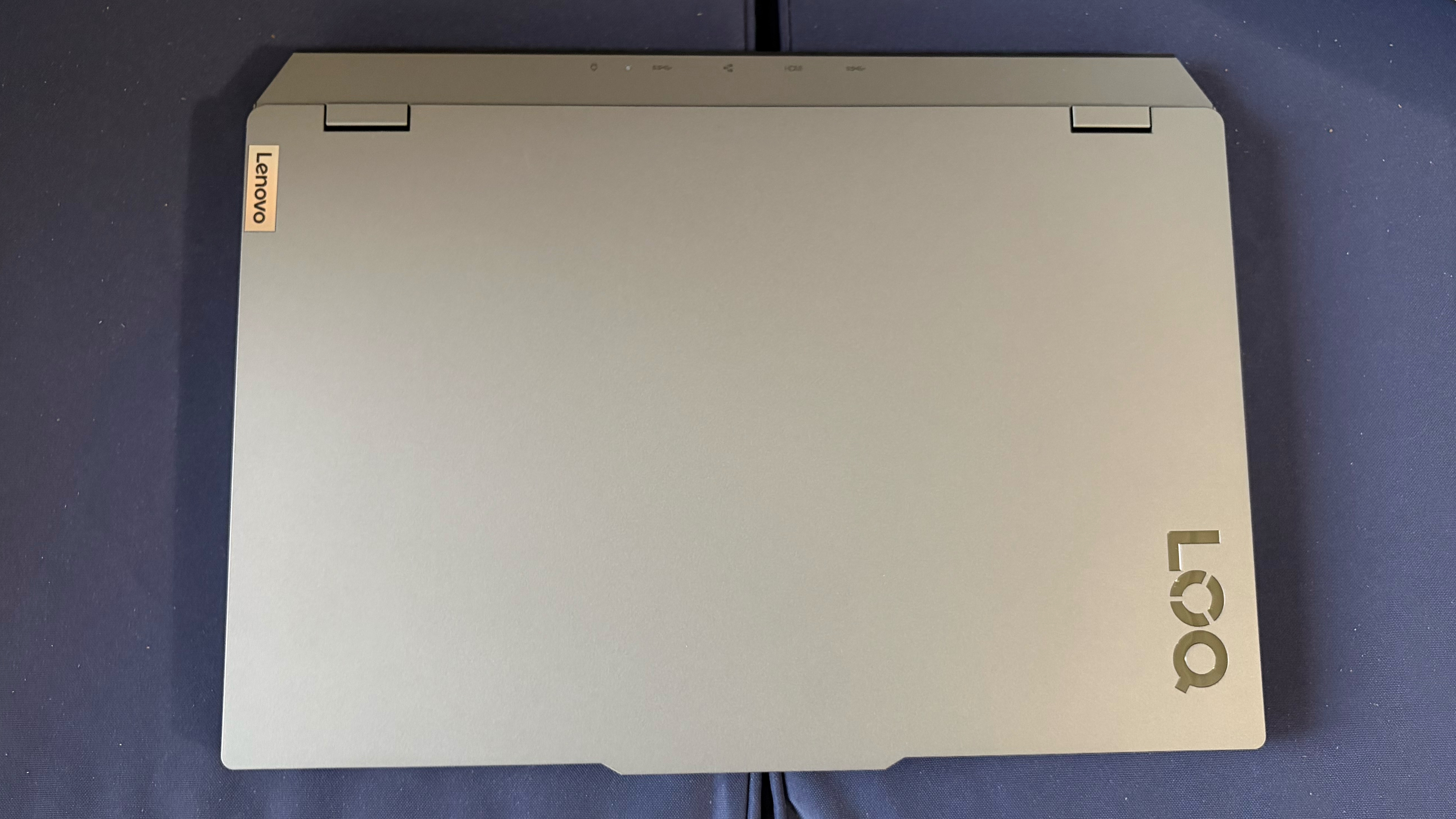
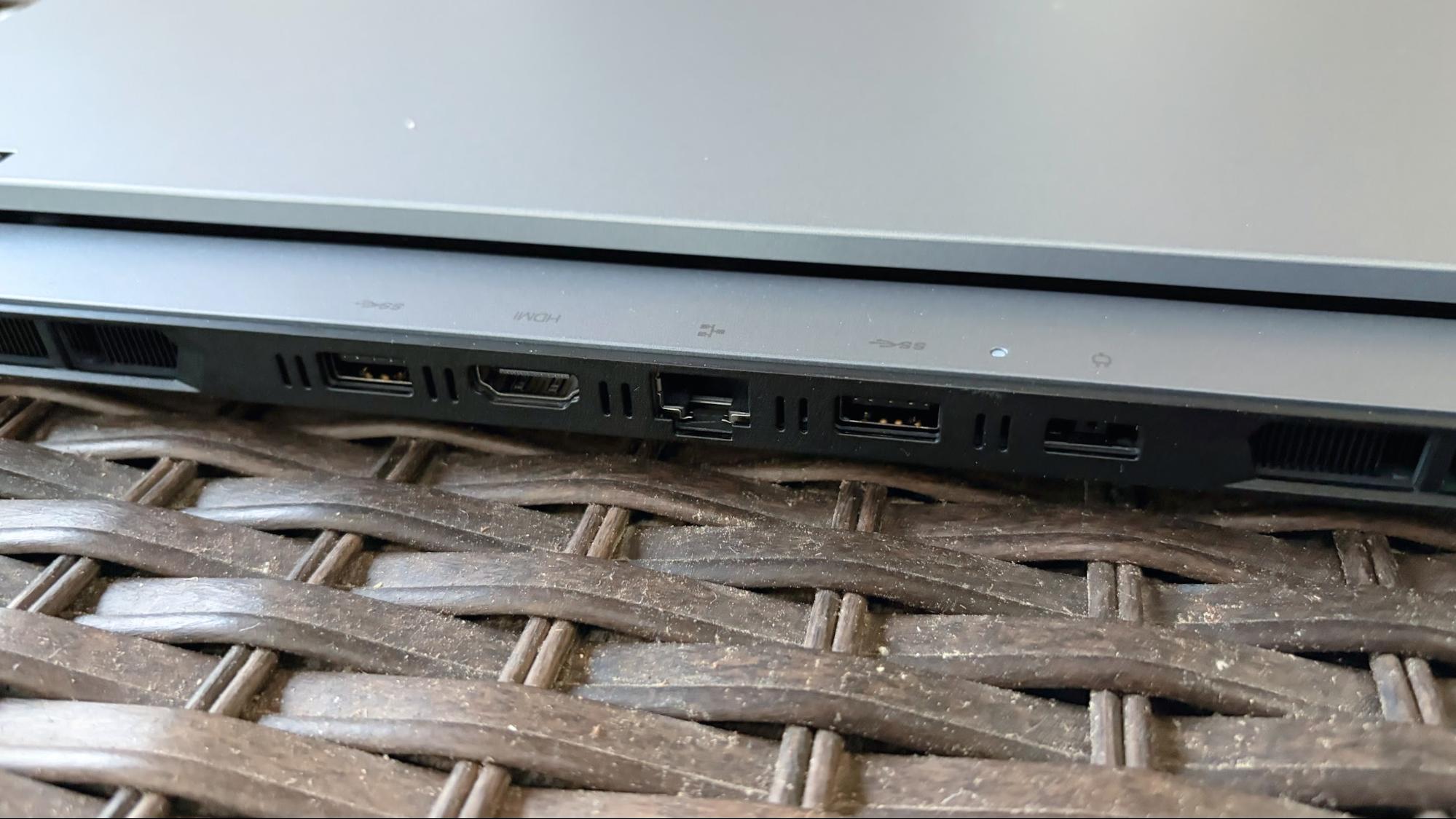
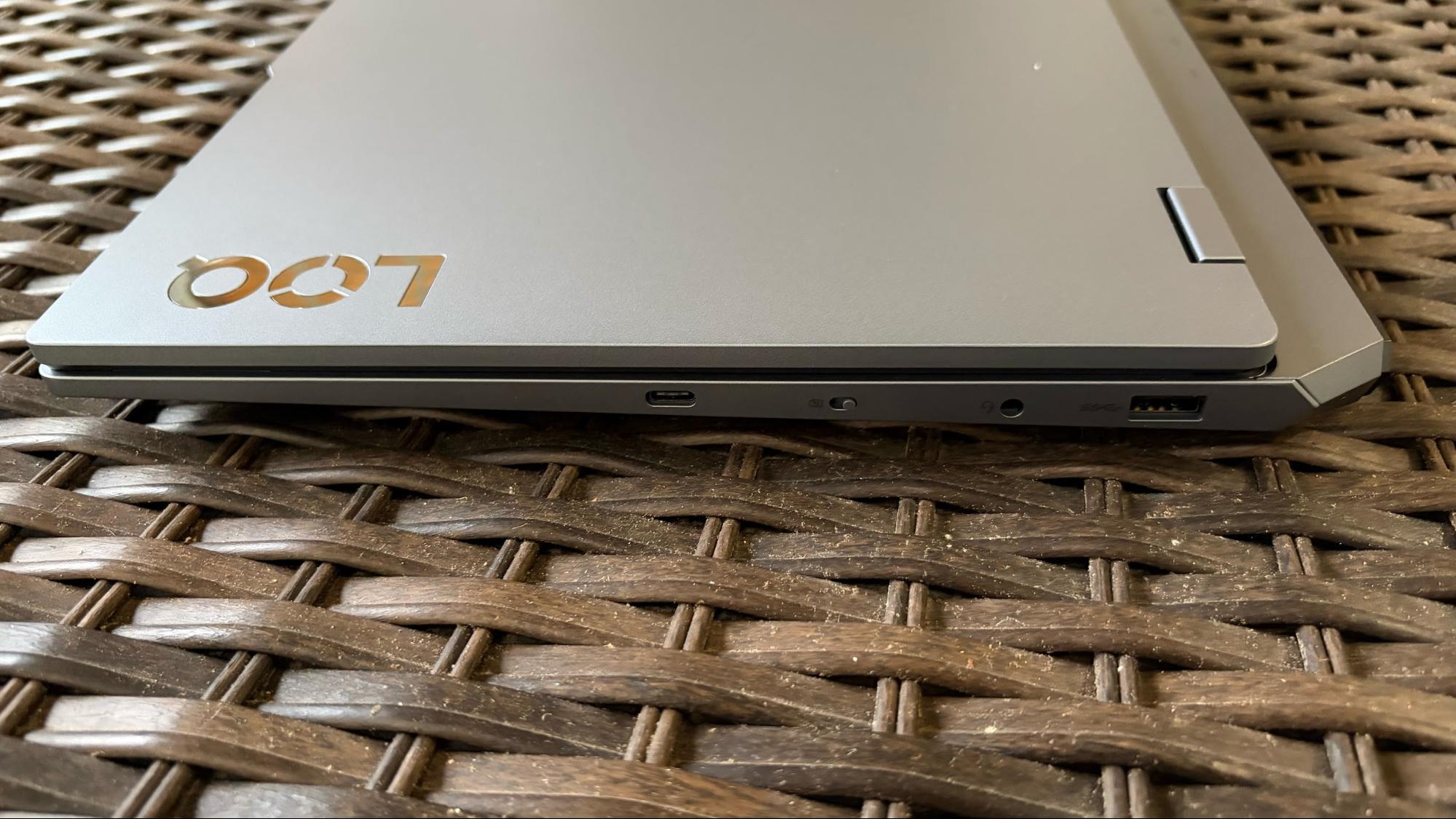
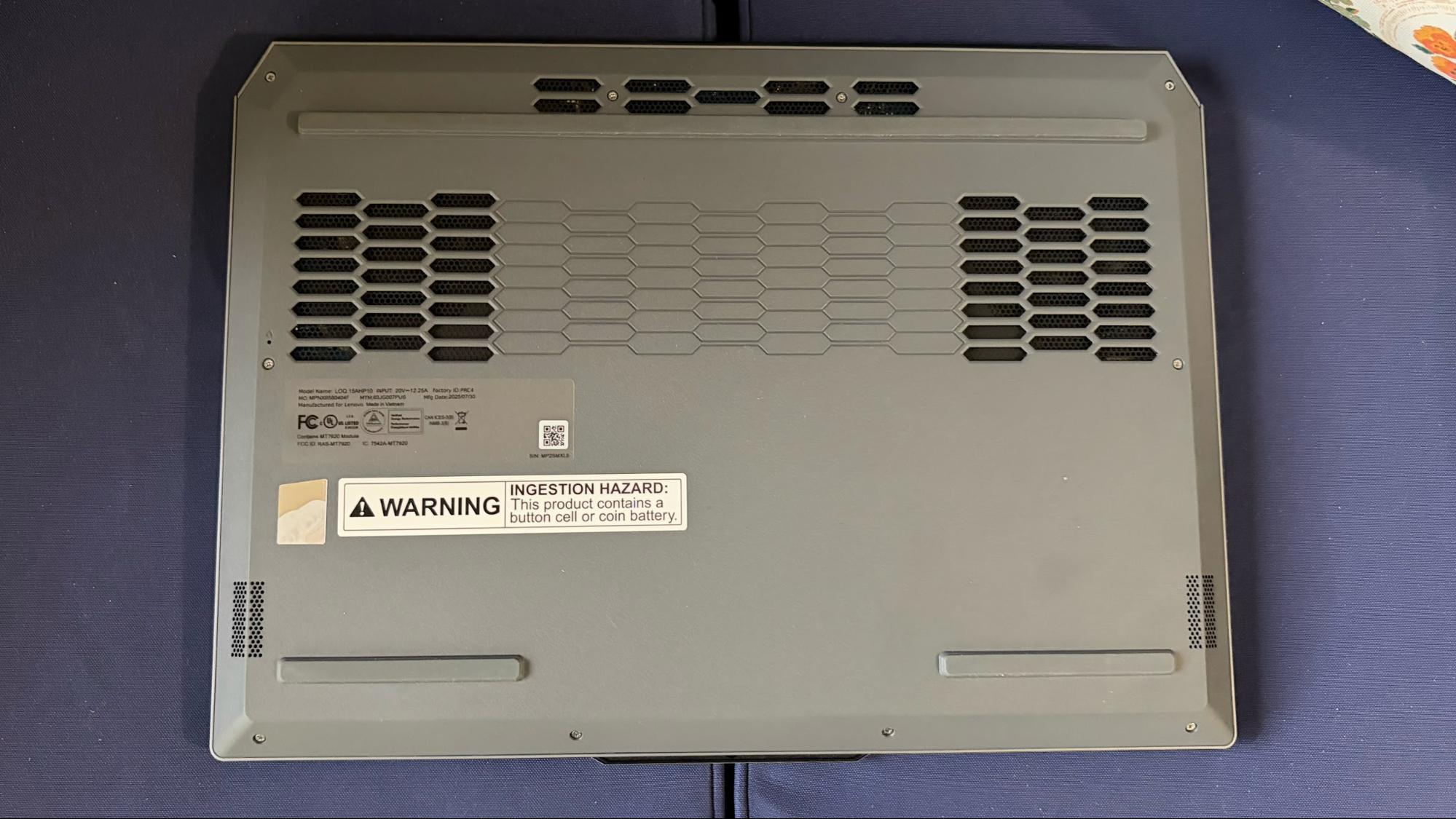
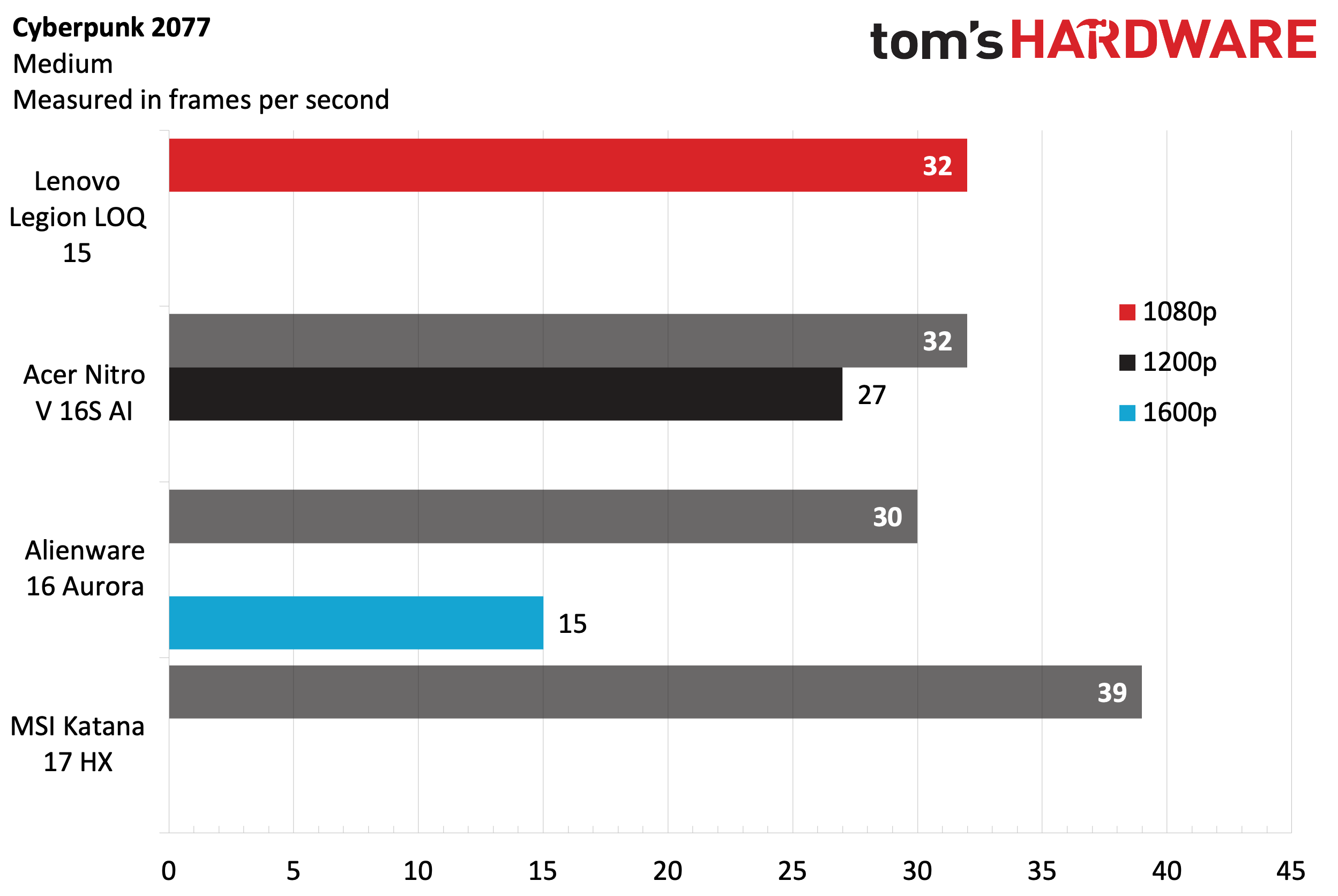
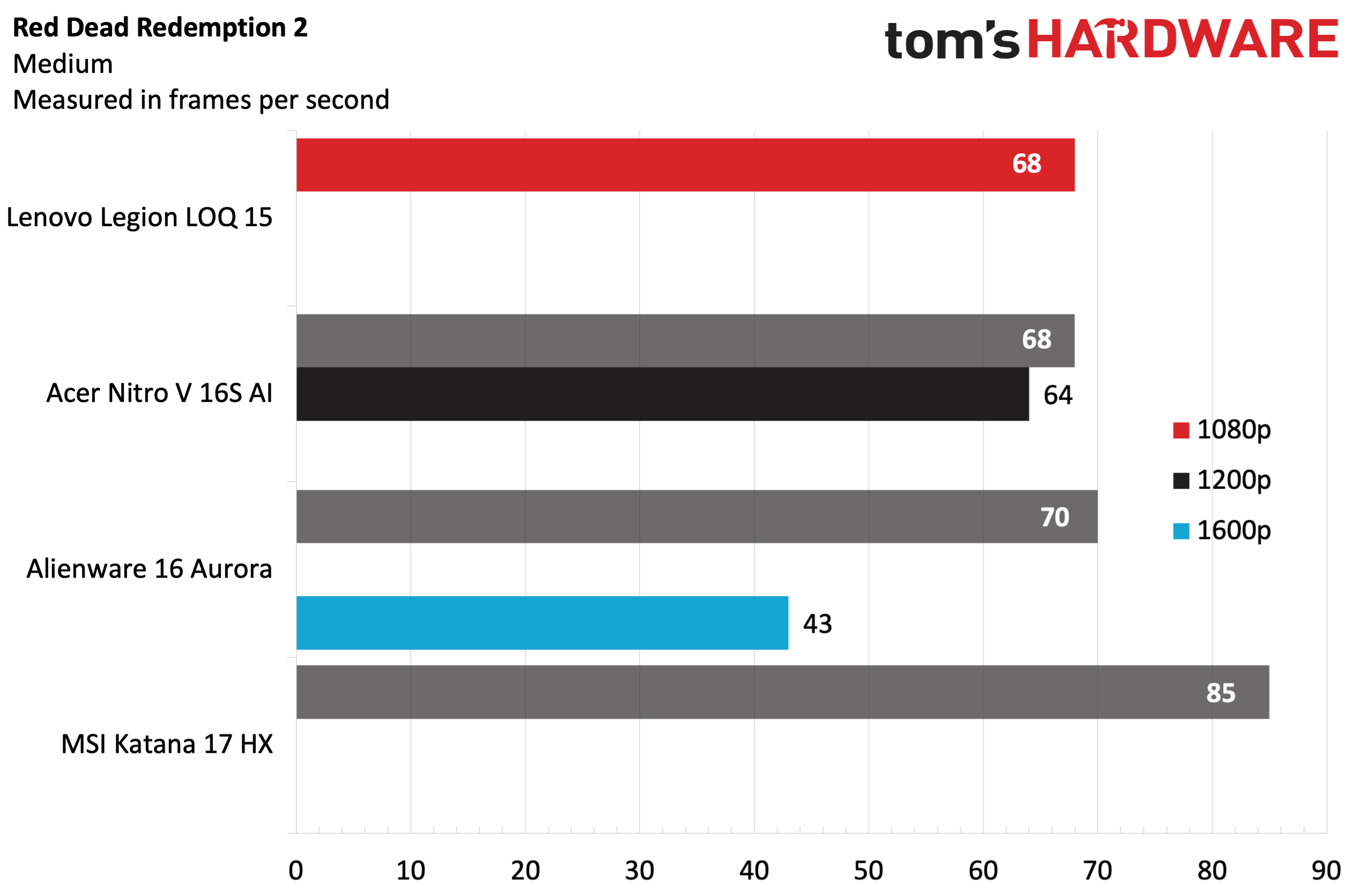
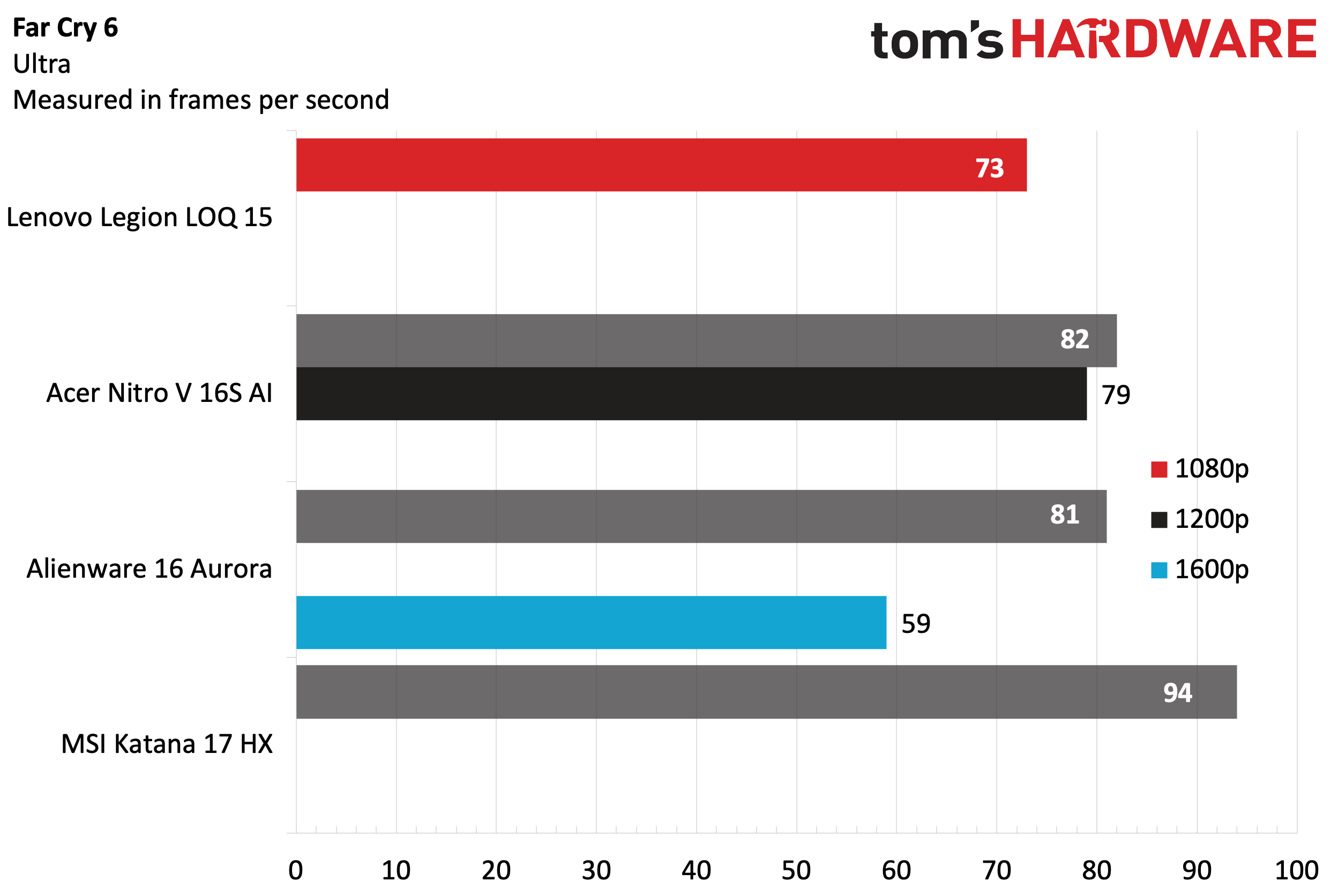
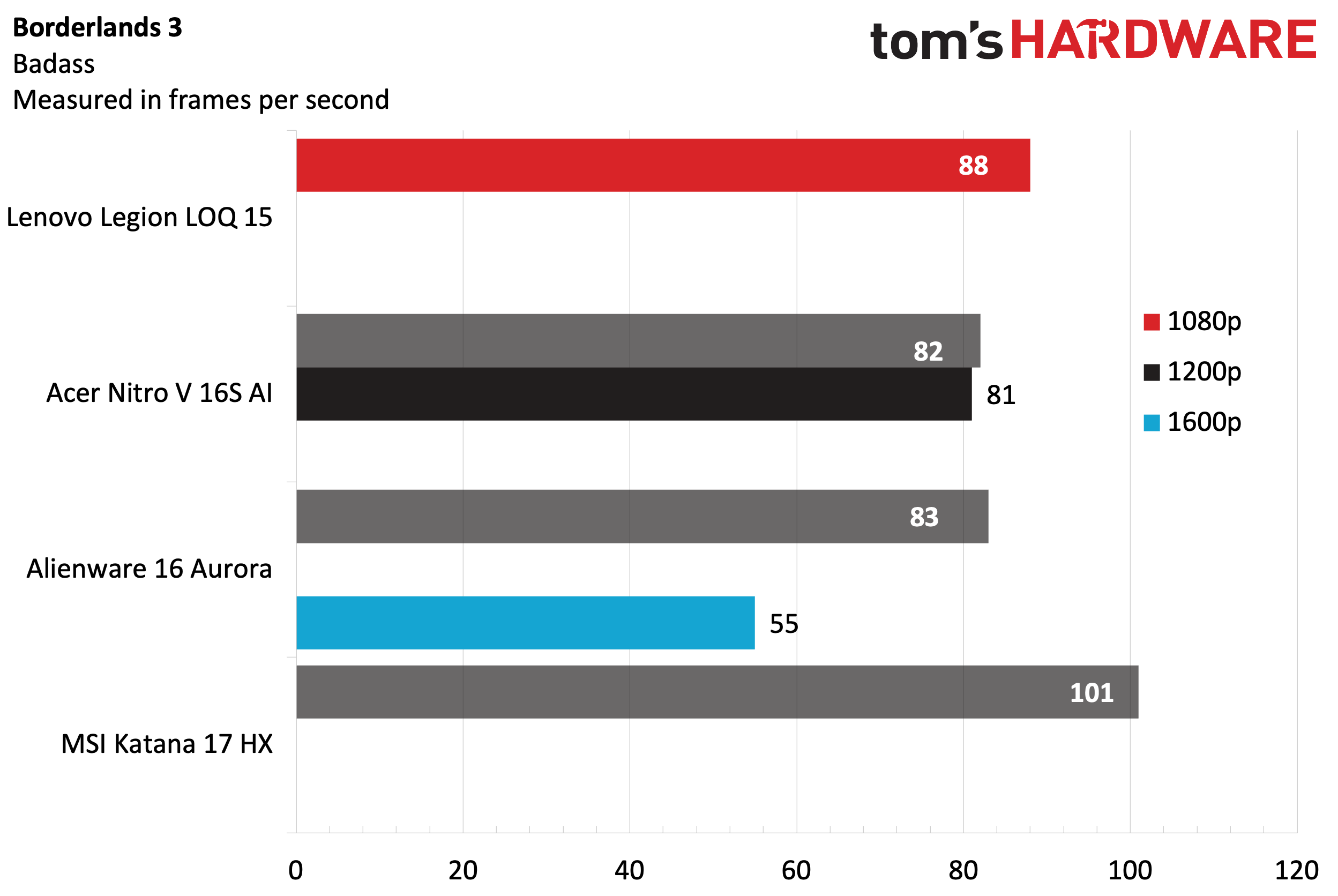
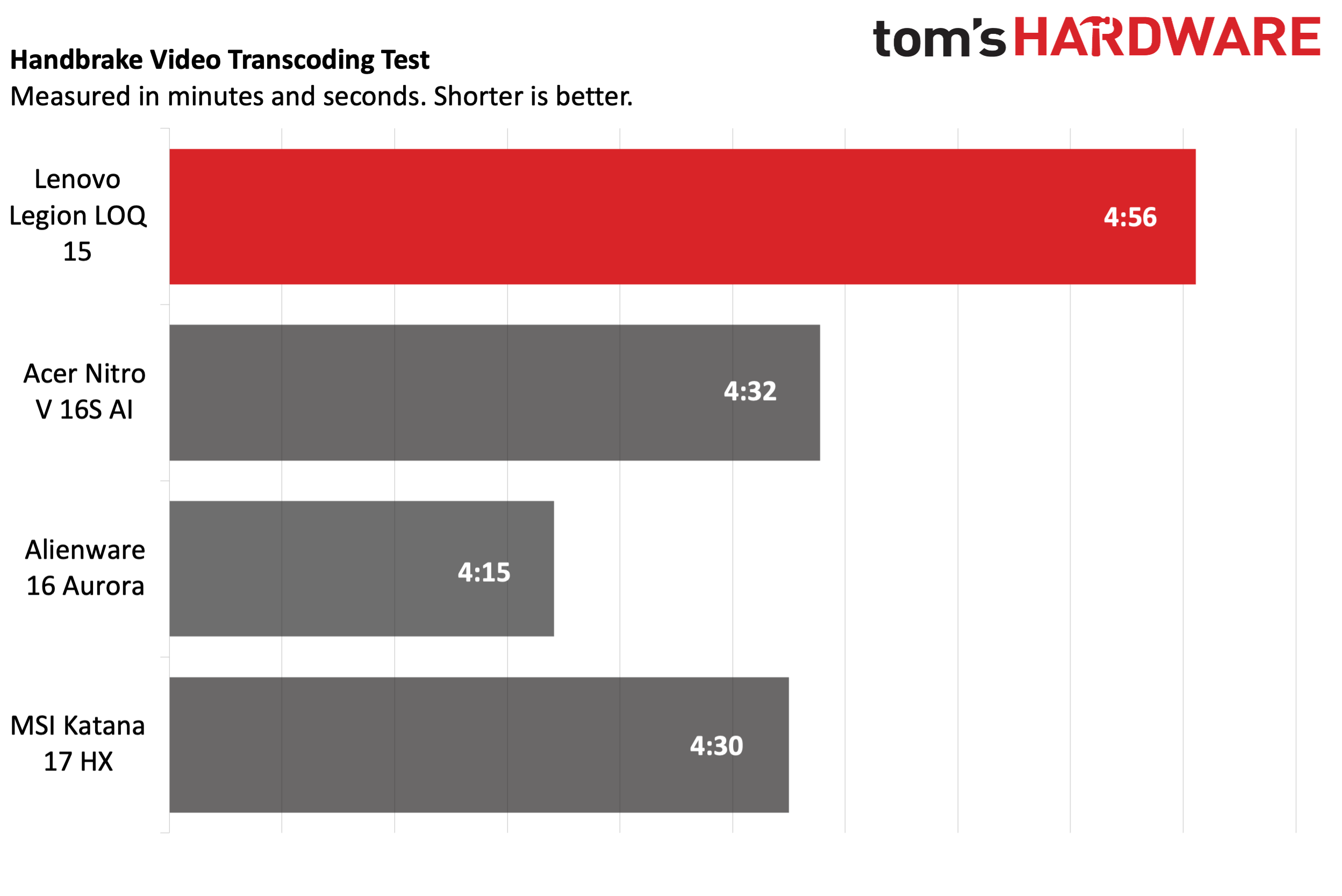
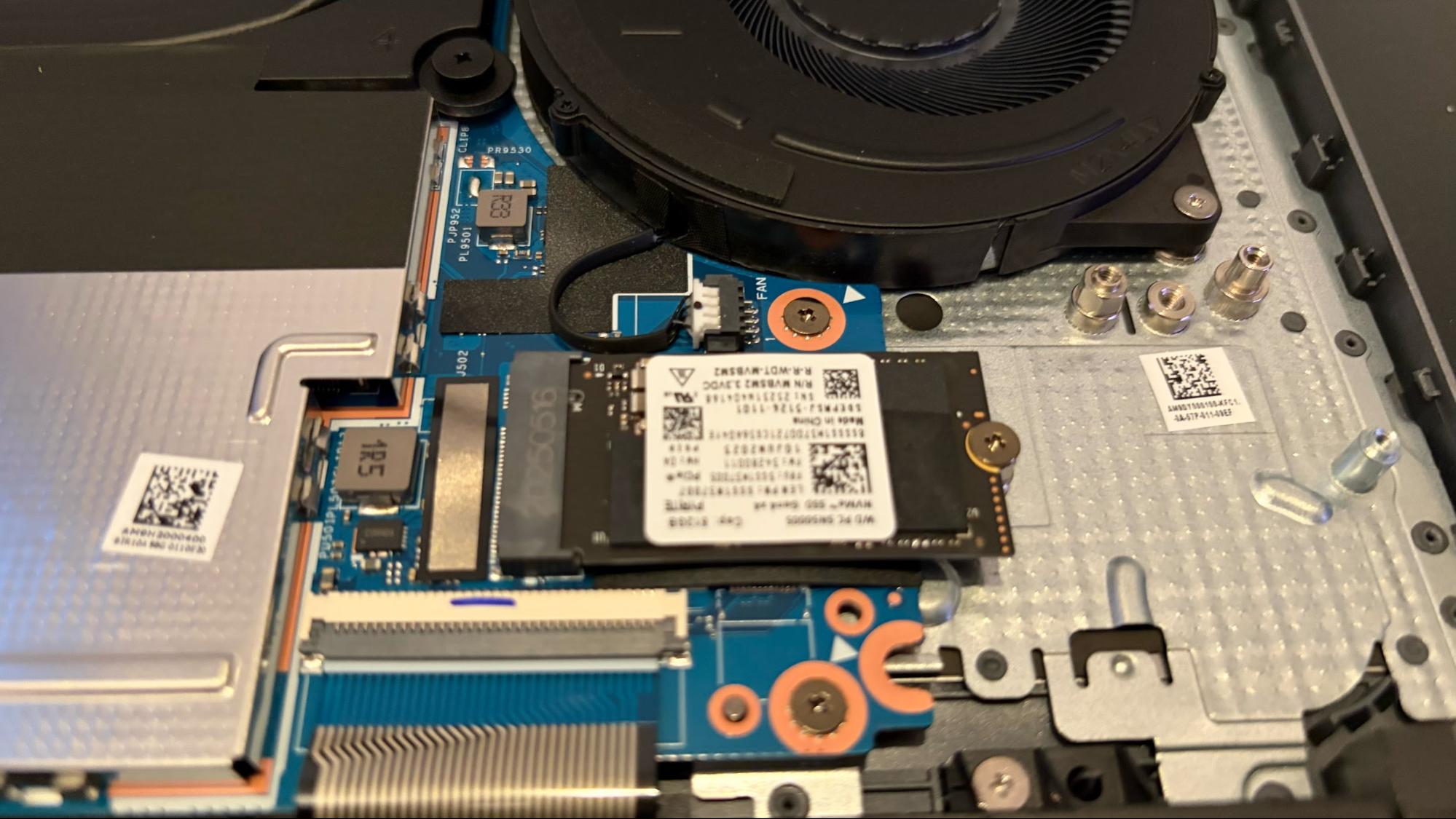
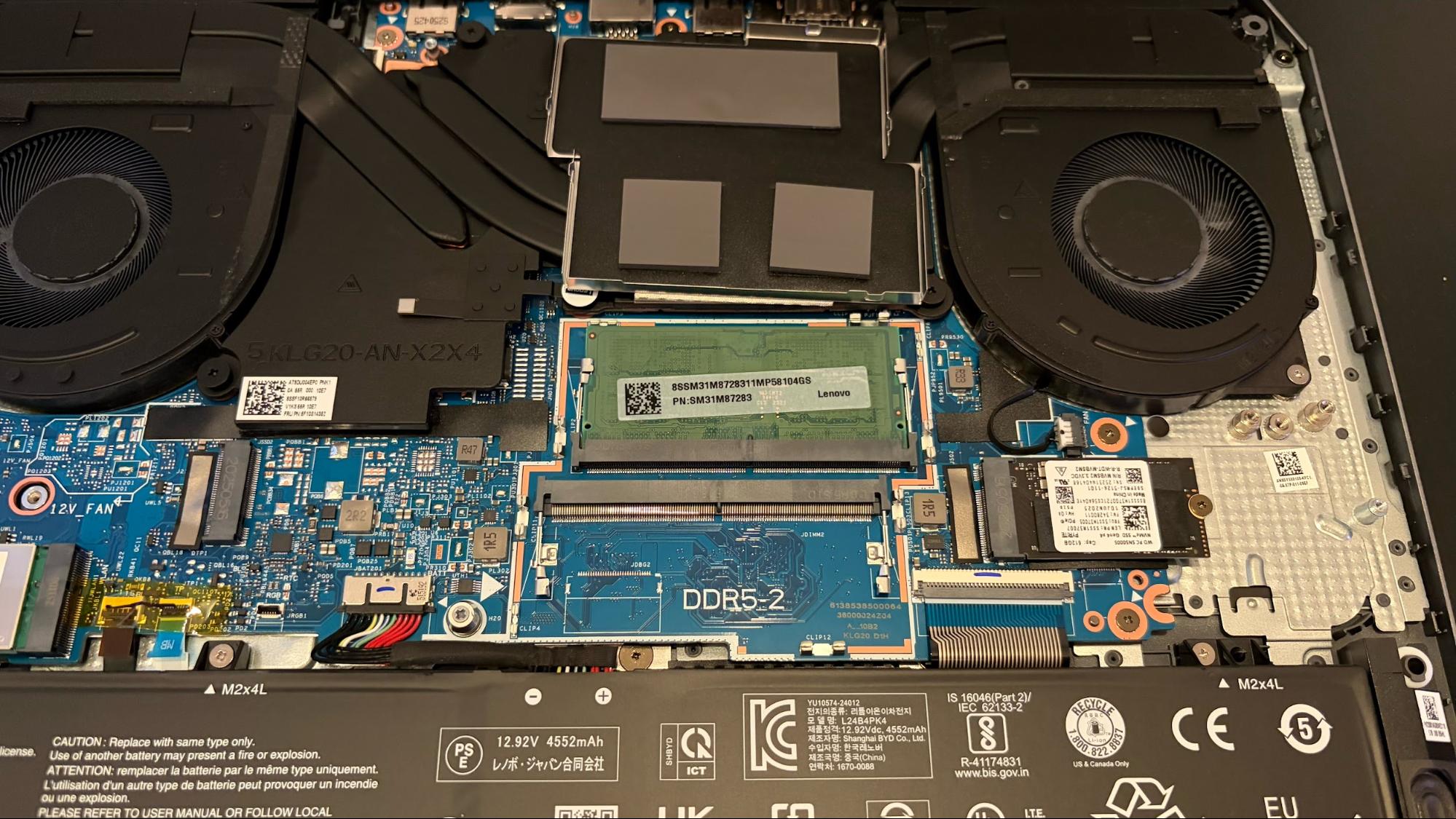
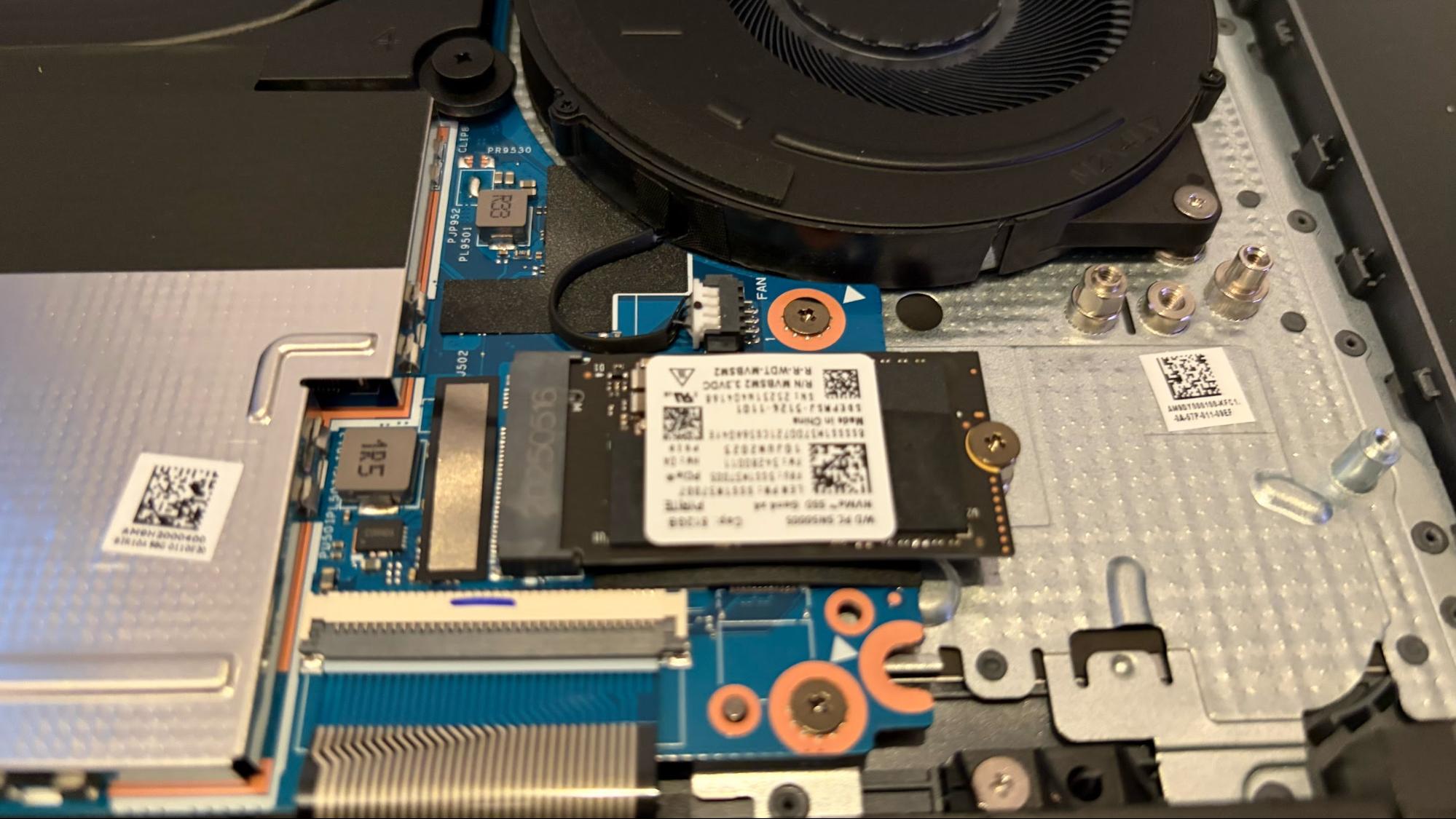
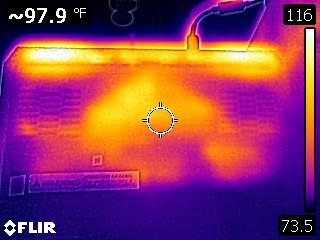

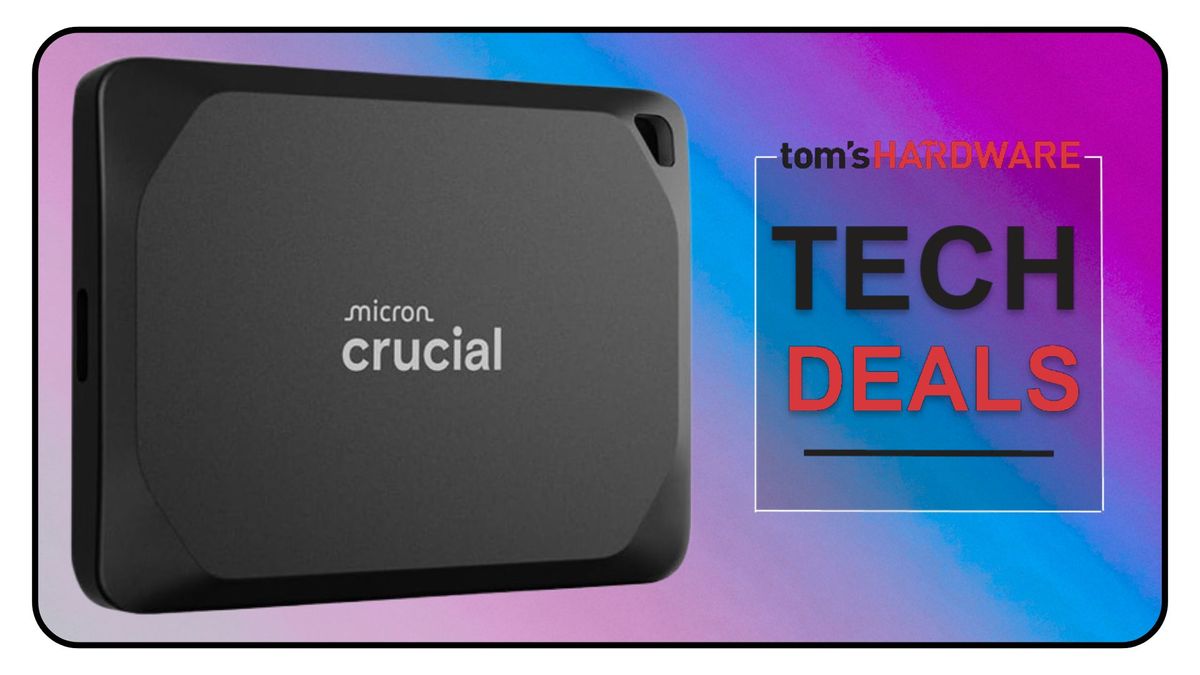
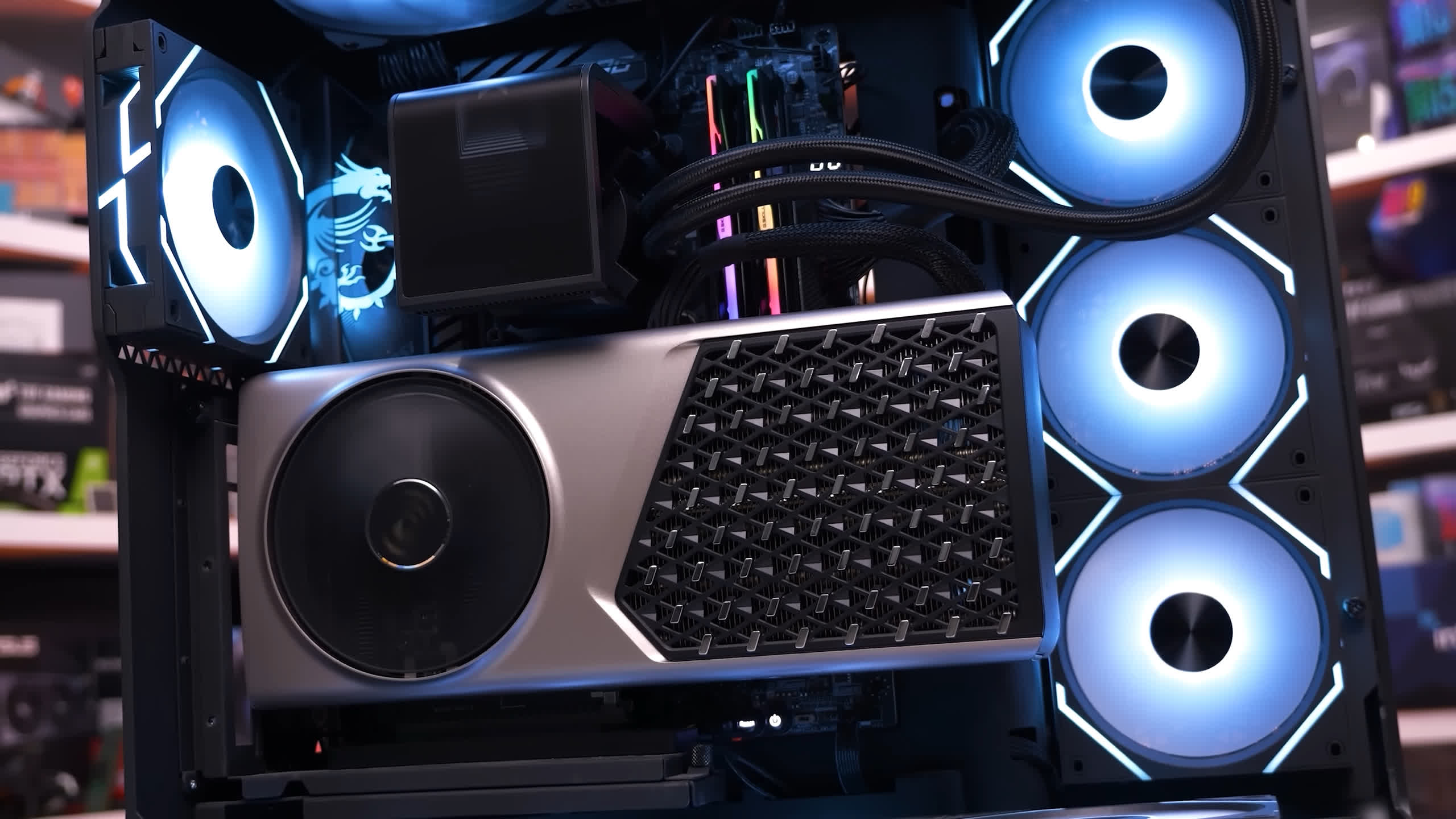
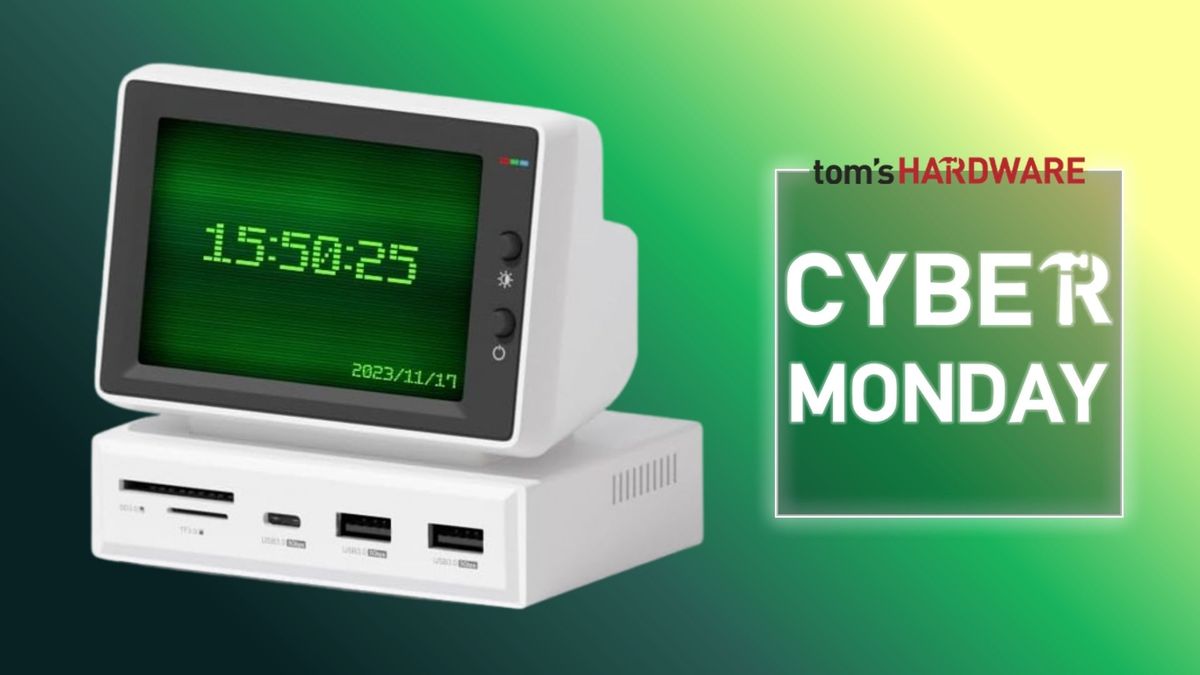

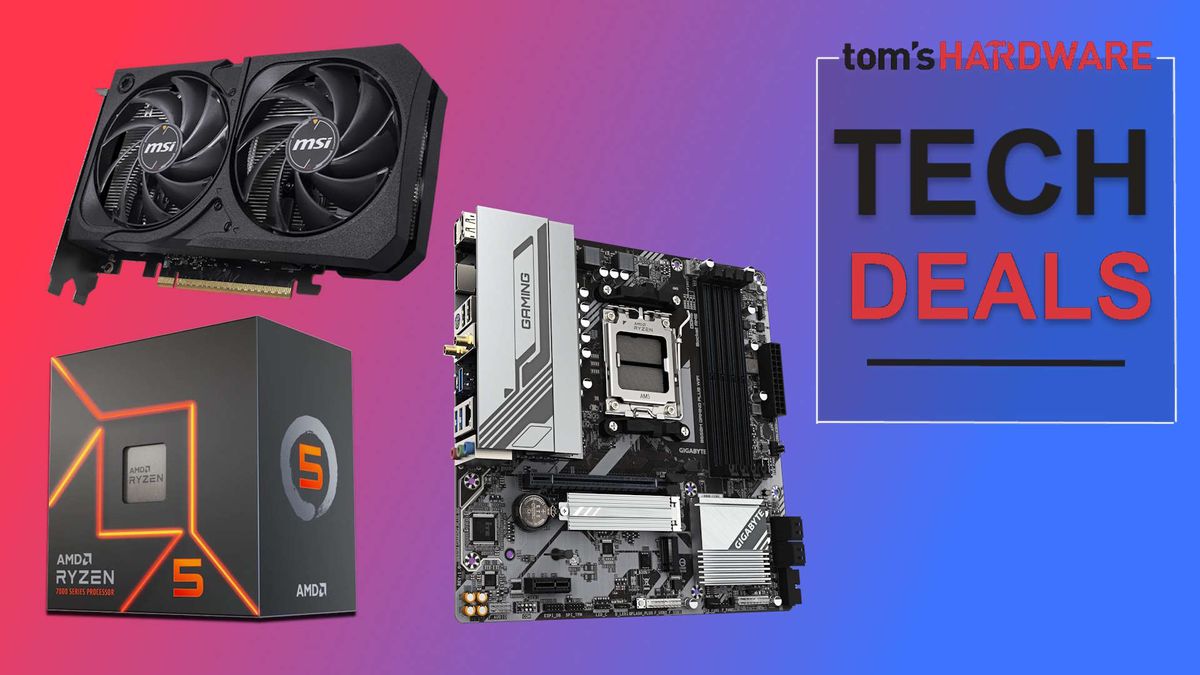


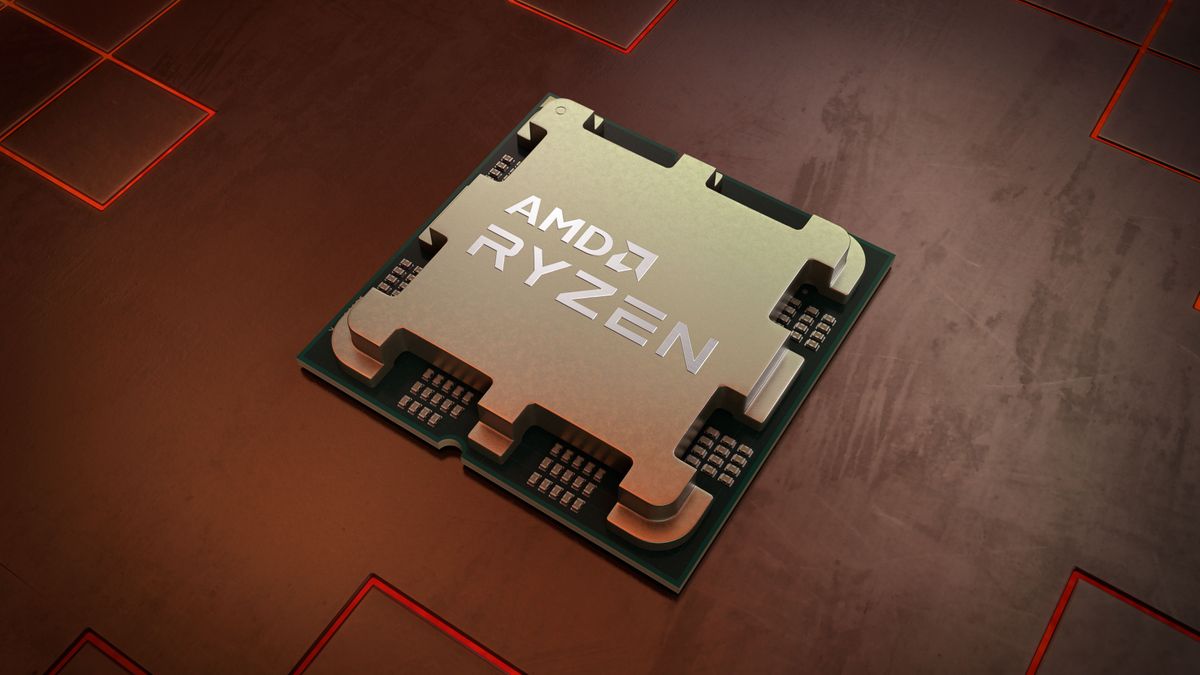
 English (US) ·
English (US) ·